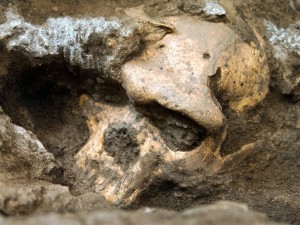 DMANISI, Georgia – The discovery of an ancient human skull in the Asian country of Georgia has thrown the proverbial monkey wrench into the theory of human evolution.
DMANISI, Georgia – The discovery of an ancient human skull in the Asian country of Georgia has thrown the proverbial monkey wrench into the theory of human evolution.
On October 18th, Science Magazine published a journal article titled, “A Complete Skull from Dmanisi, Georgia, and the Evolutionary Biology of Early Homo.” The article records the discovery of a human skull found in Dmanisi, Georgia, where numerous other ancient human remains have been discovered.
The skull had been discovered in 2005; however, as explained in the journal article abstract, scientists have only recently determined the significance of the skull.
“Here we report on a new cranium from Dmanisi that, together with its mandible, represents the world’s first completely preserved adult hominid skull from the early Pleistocene,” the abstract reports. “The Dmanisi sample, which now comprises five crania, provides direct evidence for wide morphological variation within and among early Homo paleodemes. This implies the existence of a single evolving lineage of early Homo, with phylogeographic continuity across continents.”
For evolutionists, the skull presents a major problem. According to naturalistic dating methods, the specimen is nearly 2 million years old. Yet, despite the alleged ancient age, the skull is similar to today’s cranial structures, with differences that could fit into variation levels of modern humans.
For decades, evolutionists have claimed that different human species evolved at different rates in various locations. However, the skull discovery in Georgia shows that there was actually much more continuity than predicted, with only one distinct lineage of humans. Critics of evolution say this discovery lends support to the creationist model of human history, since the Bible outlines that all nations were “made of one blood” (Acts 17:26).
David Lordkipanidze, lead study author for the research, admitted that the skull discovery in Georgia has forced anthropologists to reconsider long-held evolution premises regarding the history of humans across the world. As Lordkipanidze put it, evolutionary scientists are now “rethinking what happened in Africa.”
Major mainstream outlets are also reporting how the Georgia skull has presented a significant challenge to evolutionary theory.
“[The skull discovery] has led researchers to a surprising conclusion: Specimens that supposedly represent several early human species might be merely different-sized individuals from the same species,” NBC News reports. “If the conclusion holds up, the skull discovery would require a major rewrite for the story of early human evolution.”
“[R]esearchers suggest that the fossil record of what have been considered different Homo species from this time period … could actually be variations on a single species, Homo erectus,” CNN explains. “That defies the current understanding of how early human relatives should be classified.”
“Modern humans have an enormous variation in statute (4 to 7 feet), physical appearance (coal black aborigines to lily white Scandinavians), and brain capacity (700 to 2000 cc),” writes Bruce Malone in his book Censored Science. “It is apparent from the fossil record that this human disparity was larger in the past. … It is also apparent that fully human skull shapes were more diverse in the past.”
“None of this dissimilarity is proof of evolution,” Malone continues, “but simply of the enormous variety created within the original human gene pool.”
“Why aren’t erectus-like skulls found in rocks assigned with old ages,” Malone concludes, “also explained as simply the result of human variation, disease, or environmental causes? This blatant inconsistency in the handling of human fossils is strong evidence that there is something very suspicious about the all-pervading ‘apelike-creature-to-man’ evolution story.”
Photo: National Geographic
Become a Christian News Network Supporter...


